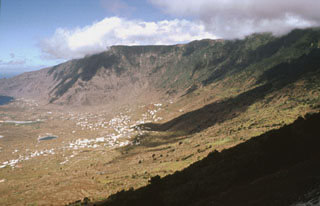Report on Hierro (Spain) — 28 December-3 January 2012
Smithsonian Institution / US Geological Survey
Weekly Volcanic Activity Report, 28 December-3 January 2012
Managing Editor: Sally Sennert.
Please cite this report as:
Global Volcanism Program, 2011. Report on Hierro (Spain) (Sennert, S, ed.). Weekly Volcanic Activity Report, 28 December-3 January 2012. Smithsonian Institution and US Geological Survey.
Hierro
Spain
27.73°N, 18.03°W; summit elev. 1500 m
All times are local (unless otherwise noted)
Instituto Geográfic Nacional (IGN) reported that during 28 December-3 January, the submarine eruption continued S of El Hierro Island. The tremor signal almost disappeared for a few hours on 28 December, after three hours with pulses every 30 seconds. The tremor amplitude started increasing again at approximately 16:35. Most of the days, large lava fragments and fine material could be observed on the emission area.
Twenty-four seismic events were located during this period, most of them grouped in the central part of the island, extending offshore both to the N and S. The depth of most of these events ranged between 9 and 23 km, with a maximum magnitude of 2.5. GPS data analyses showed very little deformation, with a slight trend to the N in the stations located at the N of the island.
Geological Summary. The triangular island of Hierro is the SW-most and least studied of the Canary Islands. The massive shield volcano is truncated by a large NW-facing escarpment formed as a result of gravitational collapse of El Golfo volcano about 130,000 years ago. The steep-sided scarp towers above a low lava platform bordering 12-km-wide El Golfo Bay, and three other large submarine landslide deposits occur to the SW and SE. Three prominent rifts oriented NW, NE, and S form prominent topographic ridges. The subaerial portion of the volcano consists of flat-lying Quaternary basaltic and trachybasaltic lava flows and tuffs capped by numerous young cinder cones and lava flows. Holocene cones and flows are found both on the outer flanks and in the El Golfo depression. Hierro contains the greatest concentration of young vents in the Canary Islands. Uncertainty surrounds the report of an eruption in 1793. A submarine eruption took place about 2 km SSW off the southern point of the island during 2011-12.

